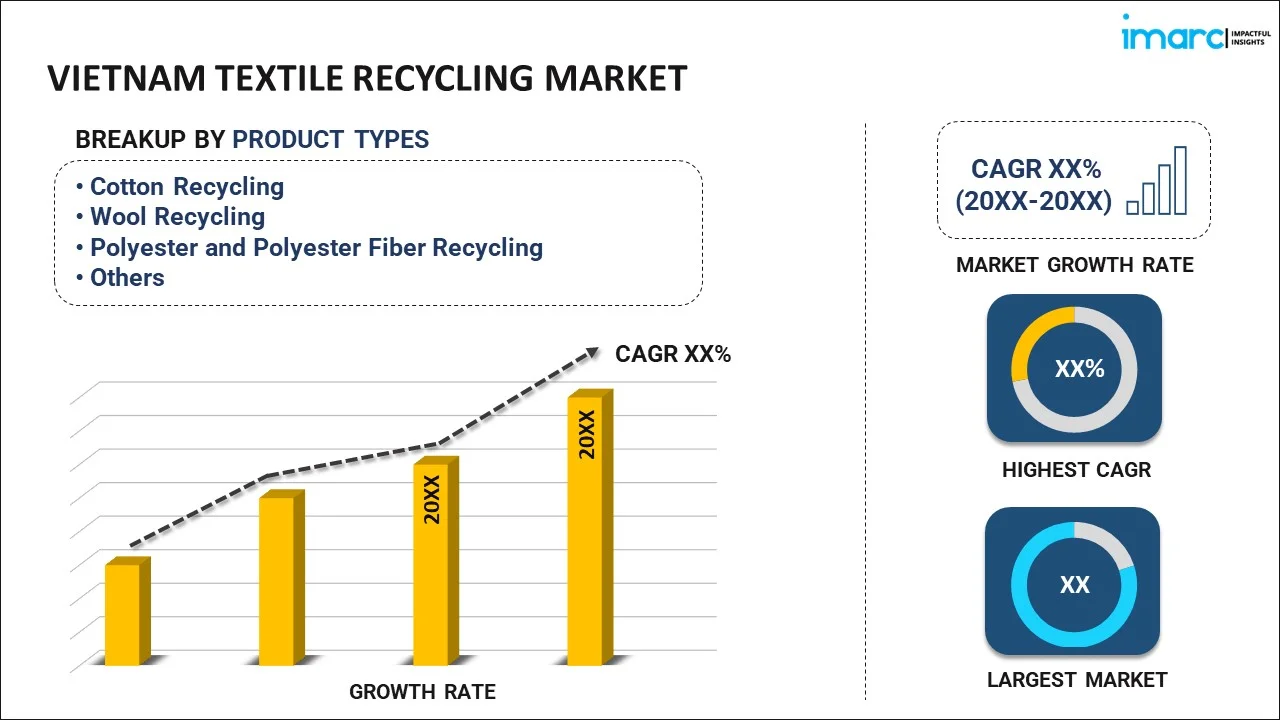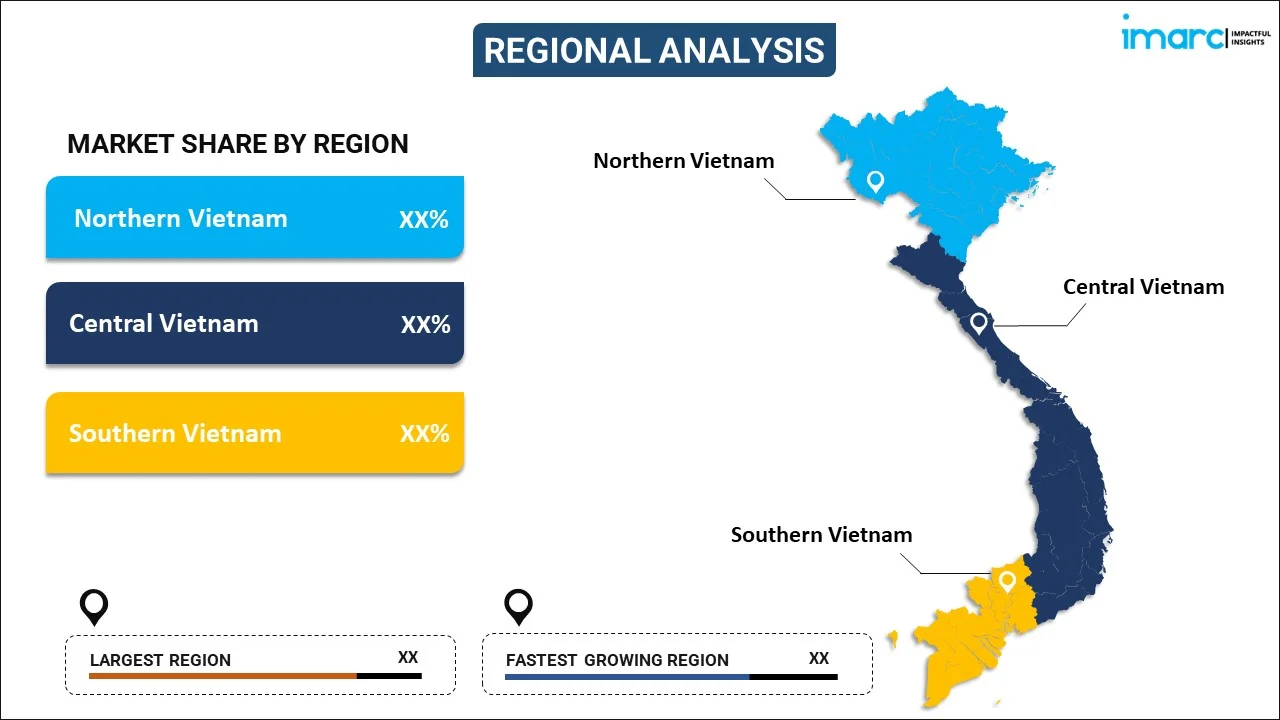
Vietnam Textile Recycling Market Report by Product Type (Cotton Recycling, Wool Recycling, Polyester and Polyester Fiber Recycling, Nylon and Nylon Fiber Recycling, and Others), Textile Waste (Pre-consumer Textile, Post-consumer Textile), Distribution Channel (Online Channel, Retail and Departmental Store), End User (Apparel, Industrial, Home Furnishings, Non-woven, and Others), and Region 2026-2034
Market Overview:
Vietnam textile recycling market size reached USD 28.2 Million in 2025. Looking forward, IMARC Group expects the market to reach USD 34.0 Million by 2034, exhibiting a growth rate (CAGR) of 2.10% during 2026-2034. The growing awareness of sustainable practices among consumers, escalating cost of waste disposal, significant growth in the fast fashion industry, the implementation of various government incentives and policies, and the presence of a robust textile manufacturing sector in Vietnam represent some of the key factors driving the market.
|
Report Attribute
|
Key Statistics
|
|---|---|
|
Base Year
|
2025 |
|
Forecast Years
|
2026-2034
|
|
Historical Years
|
2020-2025
|
| Market Size in 2025 | USD 28.2 Million |
| Market Forecast in 2034 | USD 34.0 Million |
| Market Growth Rate (2026-2034) | 2.10% |
Access the full market insights report Request Sample
Textile recycling refers to the method of reprocessing and reusing clothing, fibrous material, and clothing scraps from the manufacturing process. It involves sorting natural fibers, synthetic materials, and a blend of both, followed by mechanical or chemical processing to break them down into their core components for repurposing. Textile recycling is widely used for the production of new garments, industrial materials, upholstery, insulation, and automotive industry components, among others. It aids in conserving the environment, reducing landfill use, lowering the demand for virgin resources, and minimizing the carbon footprint associated with textile production. In addition to this, textile recycling is known for its economic efficiency, energy savings, waste minimization, resource conservation, fostering sustainable consumption patterns, and generating employment in recycling sectors.
Vietnam Textile Recycling Market Trends:
The growing awareness of sustainable practices among consumers in Vietnam, which is elevating the demand for recycled textiles, is propelling the market growth. Additionally, the escalating costs of waste disposal, encouraging businesses to invest in recycling technologies, is catalyzing the market growth. Besides this, the easy availability of advanced textile recycling technologies, which is facilitating higher recovery rates, is boosting the market growth. Furthermore, the significant growth in the fast fashion industry, which results in quicker turnover of garments, subsequently leading to more materials available for recycling, is fueling the market growth. In addition, the imposition of various government incentives and policies aimed at promoting environmental sustainability is supporting the market growth. Apart from this, the presence of a robust textile manufacturing sector in Vietnam, which supplies a significant amount of material for recycling, is contributing to the market growth. Moreover, the escalating influx of second-hand clothing through international trade, providing raw materials for the recycling industry, is driving the market growth. Along with this, the growing number of fashion brands that are committing to sustainable practices, including the use of recycled materials, is favoring the market growth. Additionally, the ongoing push by environmental campaigns and non-governmental organizations for a circular economy in textiles is stimulating the market growth. In line with this, the increasing investment in research and innovation for recycling technologies, which is improving the quality of recycled products, is positively impacting the market growth. Furthermore, the establishment of a formal sector for textile waste collection in Vietnam, which enhances the efficiency of the recycling process, making it more cost-effective, is accelerating the market growth. Besides this, the growing export market for recycled textiles from Vietnam, owing to the high quality and competitive pricing, is bolstering the market growth. In addition, the escalating partnerships between global fashion brands and local recyclers are strengthening the market growth.
Vietnam Textile Recycling Market Segmentation:
IMARC Group provides an analysis of the key trends in each segment of the market, along with forecasts at the country level for 2026-2034. Our report has categorized the market based on product type, textile waste, distribution channel, and end user.
Product Type Insights:

To get detailed segment analysis of this market Request Sample
- Cotton Recycling
- Wool Recycling
- Polyester and Polyester Fiber Recycling
- Nylon and Nylon Fiber Recycling
- Others
The report has provided a detailed breakup and analysis of the market based on the product type. This includes cotton recycling, wool recycling, polyester and polyester fiber recycling, nylon and nylon fiber recycling, and others.
Textile Waste Insights:
- Pre-consumer Textile
- Post-consumer Textile
A detailed breakup and analysis of the market based on the textile waste have also been provided in the report. This includes pre-consumer textile and post-consumer textile.
Distribution Channel Insights:
- Online Channel
- Retail and Departmental Store
The report has provided a detailed breakup and analysis of the market based on the distribution channel. This includes online channel and retail and departmental store.
End User Insights:
- Apparel
- Industrial
- Home Furnishings
- Non-woven
- Others
A detailed breakup and analysis of the market based on the end user have also been provided in the report. This includes apparel, industrial, home furnishings, non-woven, and others.
Regional Insights:

To get detailed regional analysis of this market Request Sample
- Northern Vietnam
- Central Vietnam
- Southern Vietnam
The report has also provided a comprehensive analysis of all the major regional markets, which include Northern Vietnam, Central Vietnam, and Southern Vietnam.
Competitive Landscape:
The market research report has also provided a comprehensive analysis of the competitive landscape. Competitive analysis such as market structure, key player positioning, top winning strategies, competitive dashboard, and company evaluation quadrant has been covered in the report. Also, detailed profiles of all major companies have been provided.
Vietnam Textile Recycling Market Report Coverage:
| Report Features | Details |
|---|---|
| Base Year of the Analysis | 2025 |
| Historical Period | 2020-2025 |
| Forecast Period | 2026-2034 |
| Units | Million USD |
| Scope of the Report | Exploration of Historical Trends and Market Outlook, Industry Catalysts and Challenges, Segment-Wise Historical and Future Market Assessment:
|
| Product Types Covered | Cotton Recycling, Wool Recycling, Polyester and Polyester Fiber Recycling, Nylon and Nylon Fiber Recycling, Others |
| Textile Wastes Covered | Pre-consumer Textile, Post-consumer Textile |
| Distribution Channels Covered | Online Channel, Retail and Departmental Store |
| End Users Covered | Apparel, Industrial, Home Furnishings, Non-woven, Others |
| Regions Covered | Northern Vietnam, Central Vietnam, Southern Vietnam |
| Customization Scope | 10% Free Customization |
| Post-Sale Analyst Support | 10-12 Weeks |
| Delivery Format | PDF and Excel through Email (We can also provide the editable version of the report in PPT/Word format on special request) |
Key Questions Answered in This Report:
- How has the Vietnam textile recycling market performed so far and how will it perform in the coming years?
- What has been the impact of COVID-19 on the Vietnam textile recycling market?
- What is the breakup of the Vietnam textile recycling market on the basis of product type?
- What is the breakup of the Vietnam textile recycling market on the basis of textile waste?
- What is the breakup of the Vietnam textile recycling market on the basis of distribution channel?
- What is the breakup of the Vietnam textile recycling market on the basis of end user?
- What are the various stages in the value chain of the Vietnam textile recycling market?
- What are the key driving factors and challenges in the Vietnam textile recycling?
- What is the structure of the Vietnam textile recycling market and who are the key players?
- What is the degree of competition in the Vietnam textile recycling market?
Key Benefits for Stakeholders:
- IMARC’s industry report offers a comprehensive quantitative analysis of various market segments, historical and current market trends, market forecasts, and dynamics of the Vietnam textile recycling market from 2020-2034.
- The research report provides the latest information on the market drivers, challenges, and opportunities in the Vietnam textile recycling market.
- Porter's five forces analysis assist stakeholders in assessing the impact of new entrants, competitive rivalry, supplier power, buyer power, and the threat of substitution. It helps stakeholders to analyze the level of competition within the Vietnam textile recycling industry and its attractiveness.
- Competitive landscape allows stakeholders to understand their competitive environment and provides an insight into the current positions of key players in the market.
Need more help?
- Speak to our experienced analysts for insights on the current market scenarios.
- Include additional segments and countries to customize the report as per your requirement.
- Gain an unparalleled competitive advantage in your domain by understanding how to utilize the report and positively impacting your operations and revenue.
- For further assistance, please connect with our analysts.
 Request Customization
Request Customization
 Speak to an Analyst
Speak to an Analyst
 Request Brochure
Request Brochure
 Inquire Before Buying
Inquire Before Buying




.webp)




.webp)












